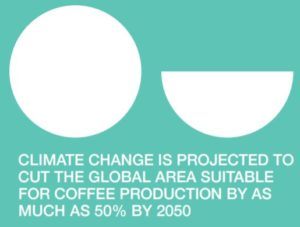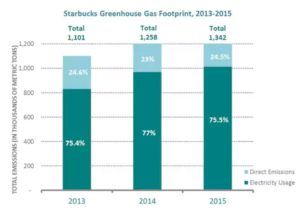Starbucks: Practicing What It Preaches When It Comes to Climate Change?

Starbucks has understandably been vocal in its support of climate initiatives, but to this point, has failed to reduce its own greenhouse emissions.
Climate change is poised to have a devastating impact on the growing of coffee beans, and as the largest seller of coffee in the world, Starbucks is certainly paying attention. Unless global emissions are reduced significantly, climate change is predicted to knock out one half of the area amenable to coffee production by 2050, as shown in Exhibit 1 [3]. Starbucks recognizes the dire implications this development could have on its business, and has been a strong supporter of inter-company climate change initiatives; however, it is struggling to reduce its own emissions.
Exhibit 1: Impact of Climate Change on Area Suitable for Growing Coffee [3]
The Consequences for Starbucks
The coffee production industry has already begun facing the challenges posed by climate change. On its website, Starbucks identifies several key present challenges – increases in erosion, pest infestation, and variability in rainfall and harvest patterns [1]. Not surprisingly, as these problems worsen over time, the shortages will reach the end consumer in the form of higher prices [2].
Starbucks currently has a vast web of suppliers generally located along the Equator, but as temperatures rise the areas suitable for coffee growth are already beginning to shift in latitude, altitude, or both. For most coffee farmers physically moving operations is a non-starter without meaningful financial support from Starbucks (or another large coffee company) [2]. With or without direct support from Starbucks, any shift in the supply chain corresponds to significant costs for Starbucks, as it needs to design new routes and potentially establish brand new relationships. A perverse reality, particularly in Asia, is that as coffee farmers relocate they will run up against tropical forests, that when destroyed will drive up emissions [3].
Partnering with the Farmers
To its credit, Starbucks has been proactive in partnering with the independent farmers supplying its coffee beans to 1) set and implement standards around effective and sustainable growing strategies and 2) test experimental crops that may be better suited to handle more extreme weather conditions. The company has worked to design seedlings that are more resistant to fungus, though to this point these beans are also slower growing [2]. In particularly fungus-infested areas, Starbucks has donated large amounts of the fungus resistant product to the local farmers that it’s partnered with. [2]. Seedling innovation is critical and needs to remain top of mind for Starbucks, as there are projections that wild coffee, which serves as a “storehouse of genetic resources,” may be extinct by 2100 [3].
Starbucks Efforts to Reduce its Energy Footprint
Starbucks, for obvious reasons, has been an early supporter of corporate climate change initiatives. The company co-founded the Business for Innovative Climate and Energy Policy, which pushes for stronger climate change policies, and is a signatory of the RE100, which is a corporate commitment to buying 100% renewable energy. The company has also made a strong push to build its stores to LEED standards [1].
Despite these efforts, Starbucks has failed to reduce its greenhouse gas emissions. In 2008, the company established a goal to cut its energy use by 25% in its stores; however, in recent years the company’s emissions have actually increased [1, 2]. This struggle has been driven by 1) an increase in the number of stores and 2) expanding into new product lines such as heated food, which require a lot more energy to store and prepare. It’s important to note that heated food has had a meaningfully positive impact on profitability [2].
Exhibit 2: Starbucks’ Emissions: 2013-2015 [1]
Now vs. Later
Until Starbucks is willing to practice what it preaches, and actually reduce its own emissions, the company should not be viewed as a leader when it comes to addressing climate change. As we see in the introduction of hot foods, it seems that immediate profits have been deemed as more important than reducing emissions. As a publicly traded company, Starbucks is undoubtedly subject to immense short-term pressure from its shareholders, but at what cost? Yes, the company has done a lot to try and reduce its footprint, but to this stage, profit maximization has ultimately won out. To this end, I think Starbucks needs to consider the following:
- For all new products that increase emissions, identify an action plan as to how this increase will be offset.
- For all new store openings, identify how the incremental emissions will be offset.
- Understand at a product level the drivers of emissions, potentially pulling even profitable products from the company’s offering.
[Word Count: 780]
Sources:
[1] “Tackling climate change,” Starbucks website, http://www.starbucks.com/responsibility/environment/climate-change, accessed 31 October 2016.
[2] Naomi Byrnes, “Starbucks Responds to Climate Change, with Mixed Results,” MIT Technology Review, May 2016, https://www.technologyreview.com/s/601404/starbucks-responds-to-climate-change-with-mixed-results, accessed 31 October 2016.
[3] Corey Watts, “A Brewing Storm: The Climate Change Risks to Coffee,” The Climate Institute, August 2016, http://www.climateinstitute.org.au/verve/_resources/TCI_A_Brewing_Storm_FINAL_WEB270916.pdf, accessed 31 October 2016.





Jasper, reading this post I couldn’t help but draw parallels between Starbucks and Ikea. Both companies seem to face decisions about how to meet their growth goals while simultaneously managing the environmental impact of sourcing a key input in their businesses. Do you think it makes sense for Starbucks to vertically integrate or to build a greater economic interest in the coffee bean business? Alternatively, do you think Starbucks could diversify away from coffee to decrease its reliance on the commodity in the way that Ikea might move to wood substitutes? Do you think a Starbucks customer could be moved to order more tea, or could Starbucks leverage its brand to promote new morning beverages altogether? All in all, really interesting post that raises a lot of interesting questions about a company we all interact with regularly. Thanks for sharing.
In reading this post, I wonder the feasibility for Starbucks to sustain/grow profits while meeting sustainability goals. You did a great job of highlighting the tension that arises between these two metrics especially given the pressures Starbucks face as a public company. It would be interesting to see whether Starbucks can quantify the long-term financial benefits of the short-term investment (i.e. reduction of profits) to achieve more sustainable means of operating (growing beans, store operations, etc.). As Sam mentioned, the challenges Starbucks face are reminiscent to that of IKEA. It would be interesting to see how Starbucks has categorized strategies into short-term (to satisfy investor demands) vs. long-term (to achieve sustainability goals).
In your article, you write, “Starbucks, for obvious reasons, has been an early supporter of corporate climate change initiatives.” I would have been interested to see you discuss Starbucks’ motivation for supporting climate change initiatives in more depth. Do you think Starbucks supports climate change initiatives because of a deep-held sense of social responsibility or does Starbuck’s support these initiatives to strengthen its appeal to customers who care about these issues?
Given Starbucks inability to address their own environmental footprint, I would argue that Starbucks is merely paying lip service to supporting climate change in order to appeal to its customer base.
Great article! I too have been skeptical of Starbuck’s ‘green’ operations, but have never thought to research it- so thank you!
I agree with your assessment of how their global carbon impact has increased- through opening more stores, more electricity use, and the introduction of products that require more heating/cooling etc. It makes sense that this would be the case.
I think Starbucks is being a little short-sighted. They could actually drive a lot more sales if they actually walked the walk, instead of just use sustainability as a marketing gimmick. As we learned our MKT case study, Starbucks originally appealed to affluent, white females but now appeals to everyone- millennials, college kids, and really anyone who also wants to be a part of the Starbucks brand, etc. If these customers didn’t already love Starbucks for all it is and stands for, they would fall completely head over heels for Starbucks, if Starbucks advertised that it is now sourcing energy only from renewable sources, if it had days when it donates 100% proceeds from sales of coffee to the farmers of coffee plantations, if it began selling coffee mugs made from recycled ceramic, if it published actual results from sustainability efforts on their website etc.This way, they would not even need to cut down on product offerings, which I think is a little hard to do in this stage of the game.
I should go work for Starbucks!
Jasper, that’s a great discussion. First of all, I want to say that in my opinion, one good way to assess the greenhouse gas emissions by Starbucks is looking at its GHG emissions per store. As you mentioned above, one of the reasons that drove the increase in the company’s emissions was the number of new stores, but this fact by itself doesn’t necessarily imply that Starbucks is not trying to adopt sustainable practices.
In addition to that, another interesting factor you brought relates to the tension between profits and sustainability. As Eric commented above, it is important to discuss the main reasons behind the Starbucks initiatives towards the support of social responsibility practices. Does the company have a deep-held sense of social responsibility or it just wants to strengthen its appeal to customers who care about these issues? Within this context, I think that the government can play an active role on monitoring the levels of GHG emissions in this industry and requiring certain standards that will protect the environment against the climate change effects.
Great discussion. Thanks for bringing this topic to the table!
Jasper, thank you for the insightful post! I think it’s great that you chose to inquire beyond the headlines to understand whether Starbucks is walking the talk, so to speak. Your third suggestion – that Starbucks should essentially conduct an analysis akin to activity-based costing to understand how individual products contribute to the company’s overall emissions – is creative and very thought-provoking. I’m wondering how realistic execution of this exercise would be in light of Eric’s question on whether Starbucks is genuinely concerned with countering the effects of climate change as a core component of its business strategy or whether it’s paying lip service to the issue in order to please customers. I suppose one place to start would be to understand where sustainability truly sits within the organization and how it affects decision-making at the highest strategic levels? Sam’s parallel between Starbucks and IKEA is on point; IKEA made the decision to incorporate sustainability as part of its growth strategy and seemed to allocate staff/ resources accordingly. I’m wondering whether Starbucks’ internal org chart would look similar, or whether it would mirror Siemens’ compliance department prior to its legal challenges (where the compliance department seemed to function merely as an afterthought with respect to the rest of the business)?